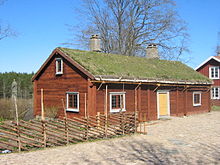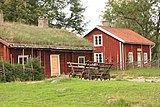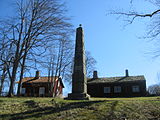Råshult
Råshult Södregård is a rectory in the parish of Stenbrohult and is located north of Älmhult in the Swedish province of Kronobergs län in the historic province of Småland . The name of the place is derived from the words Rås , which means "swampy land or valley" and hult for "small forest or wood".
The Swedish scientist Carl von Linné was born as Carl Linnæus on May 23, 1707 in the small farm of Råshult . The house built in 1706 by Linné's father Nils Linnæus burned down in the late 1720s. Today's "Linnés House" was first built between 1751 and 1781. In 1923 the local historical society initiated the restoration. It was restored in 1933. The original state has been restored.
Today there is a 42-hectare cultural reserve that reproduces the landscape that existed in the 18th century, a monument to Carl von Linné designed by the Swedish sculptor Carl Gustaf Qvarnström and a local museum.
History of the buildings in Råshult
Nils Linnæus (Nicolaus Linnæus) was appointed pastor of the parish of Stenbrohult in 1705. He moved into Råshult Södregård with his wife. The house in Råshult was a small and narrow thatched-roof house that Nils Linnæus had built himself. The son Carl was born on May 23, 1707. Only two years later the Linnæus family moved to Stenbrohult. There is the church, Stenbrohult's church, and a large rectory. Linné's mother, Christina Brodersonia, grew up there. Linné's two sisters, Anna-Maria and Sofia, were born in the rectory in Stenbrohults. His brother Samuel Linnæus, 11 years his junior, was born in 1718, also in Stenbrohult's rectory.
Linnaeus' house, local history museum, flax drying house, granary
In 1841 there were a dozen buildings in the village. Linné's house "Södregårdens", the house, the local museum and the house "Norrgårdens" remained. The flat dry house is a bit out of the way for reasons of fire protection. Especially in autumn, when the warmth outdoors was no longer sufficient to dry the flax, this was done with an open fire in the flat drying house. The granary will be built a little later.
Over the years Linnaeus's house has seen several changes. A thorough renovation took place in the 1930s, which restored the original appearance. Wooden panels on the facade and a canopy were removed. The roof, which had previously been raised, was lowered back to its original height and covered with peat. Stylish windows were used. The building got its current appearance. Linné's house became a memorial in 1977 .
Linnés Råshult cultural reserve

In 2002, Råshult became a cultural reserve. Linnés Råshult was previously cared for by the church and inaugurated on April 29, 1992 by the Bishop of Växjö, Jan Arvid Hellström.
In Linnés Råshult, the landscape was restored as it was in Linnaeus' time, with small fields, forests and meadows. The management was also gradually changed. Linnaeus's own descriptions of his trips to Öland and Gotland in 1741 and to Skåne in 1749 served as the basis of the work.
Some inspection reports from 1751-1837 have also been preserved. Great caution and patience are necessary if you want to restore a historically and biologically authentic landscape. Linnés Råshult is open to visitors. At the same time, it is also a farm that produces winter fodder for the animals in the fields. Therefore it is important to follow the prepared paths and not to step into the meadows. Several gardens were newly laid out in the cultural reserve. These gardens are cultivated according to the methods of the 18th century. Even then, there was a variety of plants in the parish garden in Råshult. The managers of the cultural reserve used Linné's writing "Adonis Stenbrohultensis", where he describes for the first time in 1731 which plants his father planted in the garden. Here he lays the first foundations for his Systema Naturae .
The cultural reserve with the Råshult rectory covers an area of 42 hectares with the farm, its areas near the farm and the outdoor areas and is located on the edge of Saw Nässjön in the municipality of Älmhult in the province of Kronobergs län . It was named a cultural reserve in 2002.
While walking along the paths, you will learn what landscape looked like in the 18th century, how it functioned and how everything grew. This landscape of the reserve is one of the few large areas that has been little affected by the "Agrarian Revolution". The old landscape of the early 18th century is shown in Råshult. The landscape consists of cultivated areas with fields and meadows, and partly also of the remote field. A short fence separates the outer field from the cultivated areas near the farm. The fields near the farm were cultivated without interruption. These old fields covered about 19 hectares. The lower salsify , arnica , quiver grass , spotted orchid , two-leaved forest hyacinth and lung gentian grow there .
The Linnés Råshult Cultural Reserve is owned by the Linnés Råshult Foundation, which is run by the Älmhult municipality and the founder is the Växjö diocese . The entire reserve is leased and managed by a family. A management plan negotiated with the state government and the owner is updated annually. The district administration of Kronoberg contributes to the restoration, preservation and maintenance with funds from the national monument authority .
Gardens in the cultural reserve
Eden
The garden is as the father Nils Linnæus laid it out with almost 300 rare plants. The plants in the raised beds form a large round lunch table with dishes and chairs for the guests.
Herb garden
Mainly medicinal herbs and aromatic plants are grown in the herb garden.
Hop garden
The plants in the hop garden were primarily of local importance. They were used to make beer.
Vegetable garden
A wide variety of vegetables and root vegetables for domestic use have been grown in the vegetable garden. Old and local varieties are grown with great care. The vegetable garden is divided into four areas with annual and perennial plants that change from year to year.
Oat plum grove
In Linnaeus's time, oat plums were common crops. A variety of spring flowering bulbs also grow in the grove.
Carl's garden
Just outside the reserve is "Carl's Garden" and this is for the youngest visitors. When Carl was 5 years old, his father had laid out his own garden for him near the rectory, in which he could plant himself. This garden was called "Carl's Garden". This garden in the cultural reserve ties in with this. It is operated as a teaching garden for children and adults.
Garden cafe
Farm and its surroundings
Archaeological digs
Råshult has been inhabited for many centuries. Archaeological digs were conducted in 2004 to see what the area might have looked like. It was found that the courtyard was partly paved with stones. The animals were led to the well in the middle of the courtyard to water. Even the dung heap used to be in the yard and not behind the houses as it is today. The new barn was built around 1870. The studies showed that Råshult used to be much more densely built than it is today.
The buildings in Råshult are in the same places as in Linnaeus' time. However, only the farmhouse, Linné's house, which, as already mentioned, was built between 1751 and 1781, dates from the 18th century. The entire complex of the property, including the gardens and the paved courtyard, was rebuilt with a lot of effort in 2006. At the same time, new fences were also erected.
Archaeologists from the Småland Museum removed the sward from the fenced yard in 2006 for more detailed investigations. Previously unknown stone foundations were discovered in the immediate vicinity of Linnaeus' house. Previously unknown foundations were also discovered in the house, which is attributed to Nils Linnæus. During the restoration of the courtyard, the old house foundations remained visible.
The archaeologists found a glass seal during excavations . This seal comes from the Henrik Torp glassworks in southern Sweden, which was in operation from 1690 to 1760. Linné wrote about his visit to the glassworks on his Skåne trip in 1749.
History of the rectory
Råshult vicarage, known as Linnaeus House, was built between 1751 and 1781. The houses that Linné's father Nicolaus (Nils) Linnés (1674–1748) and wife Christina Brodersonia (1688–1733) built in 1705–1706 burned down in the first Half of the 18th century. Father Nils Linnæus was the first pastor in Råshult. The parish existed until 1903. In the summer of 1709 the family moved from the Råshult rectory to the Stenbrohult rectory . Carl von Linné (1707–1778) was the eldest son of Nils Linné. When Carl von Linné was 11 years old, his younger brother Samuel Linnæus was born in the rectory in Stenbrohults in 1718. A church had stood in the parish of Stenbrohults since the 14th century. The parsonage also included stables, a few farmhouses, and a few houses.
Over time, Linné's house has been changed several times. Each pastor left his own mark. During the second half of the 19th century a family with many children lived here and they added an additional floor to the house. The house was a tenement house until the "Hembygdsföreningen Linné" homeland association was founded after 1903. The association then took over the management of the house and a museum in memory of Linnaeus. In the 1930s the club carried out a major renovation.
Linnaeus house was completely renovated in 2006 and got the look of the 18th century. The district administration of Kronobergs Län financed this work with funds from the Swedish Monument Preservation (Riksantikvarieämbetet) . Visitors get an idea of what it looked like when Carl Linnæus was born.
Local museum
The local history museum of the association "Hembygdsföreningen Linné" is located in a separate building directly by the cultural reserve and has the same opening times as Linnés Råshult. In the 1930s, the association also took care of Linnaeus' house and renovated it. He cultivated the memory of Linnaeus.
Other buildings and the monument
The barn was built in 1872. Part of the building serves as a lecture and exhibition space. Photos of life in the cultural landscape are shown here.
There is also a granary in the yard.
The building in which the flax was dried is a bit off. Since the drying was supported by an open fire, the distance was used for fire protection.
In memory of Carl von Linné, a memorial was erected in a small park behind Linné's house by the Swedish sculptor and painter Carl Gustaf Qvarnström . It stands right next to the newly built railroad in the 1860s. Collected donations made this memorial possible. A large inauguration ceremony took place in 1866. The front of the monument faces the railroad track so that all passers-by can see that Carl von Linné, the great son of this area, was born here.
Art in public space
In 2009 the municipality of Älmhults bought some works of art from Sven-Ingvar Johansson , who was born in Osby in Göteryd in 1962 . These are in the entrance area of Linnés Råshult.
The works of art should stimulate you to discover the little "things" in nature. Linnaeus' brother Samuel was a well-known beekeeper in his day. He was the first to write a book about beekeeping and the "excellence" of bees. With the work of art “Beehive” and some bees, the artist would like to point out Linné Bruder's interest in beekeeping and the common interest of both brothers in animals. Sven-Ingvar Johansson demonstrates animals to the visitors: woodpeckers , ants , weevils , peregrine falcons , bats , ravens and blues .
Individual evidence
- ↑ lecture by Sven Rosborn on Wikipedia Academy in Lund, Sweden, November 13, 2008. See also Linnés Råshult
- ↑ Inga Borg, Fibben Hald, I Naturens Riken, Linnés liv och Verk, En bok för alla, 1979, pp. 7–9. ISBN 91-7448-780-9 .
- ↑ a b Linnés Råshult cultural reserve. ( Memento of the original from March 7, 2016 in the Internet Archive ) Info: The archive link was inserted automatically and has not yet been checked. Please check the original and archive link according to the instructions and then remove this notice. Via Råshult on the district administration's website
- ^ Carl von Linnés resa till Skåne 1749. Wikisource, the travelogue in Swedish
- ↑ Linnés Råshult, Culture Reserve. Web site of the "Stiftelsen Linnés Råshult"
- ↑ Linnés Råshult cultural reserve. Information about Råshult from the Church of Sweden
- ↑ Linnés Råshult, Kulturreseravat. about "estate and garden environment"
Web links
Coordinates: 56 ° 37 ′ 5 ″ N , 14 ° 12 ′ 7 ″ E






















